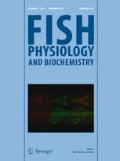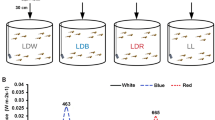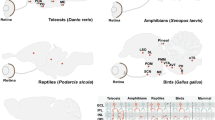Abstract
Animals regulate a variety of aspects of physiology according to environmental light conditions via nonvisual opsins such as melanopsin. In order to study photic regulation of fish physiology, expression changes of the genes for melanopsin (opn4xa and opn4xb) and effects of light on them were examined in juvenile grass puffer Takifugu alboplumbeus using quantitative real-time PCR. In the brain of juvenile fish, no significant diurnal nor circadian changes were observed in opn4x mRNA levels. On the other hand, in the eyes, the mRNA level of opn4xa showed a significant diurnal rhythm with a peak at Zeitgeber time (ZT) 4, while no apparent circadian changes were observed. The mRNA level of opn4xb in the eyes showed a diurnal change similar to that of opn4xa, while it showed a significant circadian change. Furthermore, continuous exposure to light during a subjective night significantly increased the mRNA levels of opn4xa in the eyes at ZT24, suggesting that light induces gene expression of opn4xa in the eyes and that the induction occurs only during the night-day transition period. These results suggest that Opn4xa and Opn4xb play differential roles in the eyes of juvenile grass puffer to mediate the physiological effects of environmental light information.






Similar content being viewed by others
Data availability
All data and materials are available at Niigata University. The nucleotide sequence data reported are available in the DDBJ/ENA/GenBank databases under accession numbers LC535119 and LC535120.
References
Ando H, Shahjahan M, Hattori A (2013) Molecular neuroendocrine basis of lunar-related spawning in grass puffer. Gen Comp Endocrinol 181:211–214
Ando H, Ogawa S, Shahjahan M, Ikegami T, Doi H, Hattori A, Parhar I (2014) Diurnal and circadian oscillations in expression of kisspeptin, kisspeptin receptor and gonadotrophin-releasing hormone 2 genes in the grass puffer, a semilunar-synchronised spawner. J Neuroendocrinol 26:459–467
Ando H, Shahjahan M, Kitahashi T (2018) Periodic regulation of expression of genes for kisspeptin, gonadotropin-inhibitory hormone and their receptors in the grass puffer: implications in seasonal, daily and lunar rhythms of reproduction. Gen Comp Endocrinol 265:149–153
Bedrosian TA, Fonken LK, Walton JC, Haim A, Nelson RJ (2011) Dim light at night provokes depression-like behaviors and reduces CA1 dendritic spine density in female hamsters. Psychoneuroendocrinol 36:1062–1069
Berson DM, Dunn FA, Takao M (2002) Phototransduction by retinal ganglion cells that set the circadian clock. Science 295:1070–1073
Davies WI, Zheng L, Hughes S, Tamai TK, Turton M, Halford S, Foster RG, Whitmore D, Hankins MW (2011) Functional diversity of melanopsins and their global expression in the teleost retina. Cell Mol Life Sci 68:4115–4132
Do MTH (2019) Melanopsin and the intrinsically photosensitive retinal ganglion cells: biophysics to behavior. Neuron 104:205–226. https://doi.org/10.1016/j.neuron.2019.07.016
Drivenes O, Soviknes AM, Ebbesson LO, Fjose A, Seo HC, Helvik JV (2003) Isolation and characterization of two teleost melanopsin genes and their differential expression within the inner retina and brain. J Comp Neurol 456:84–93
Eilertsen M, Drivenes O, Edvardsen RB, Bradley CA, Ebbesson LO, Helvik JV (2014) Exorhodopsin and melanopsin systems in the pineal complex and brain at early developmental stages of Atlantic halibut (Hippoglossus hippoglossus). J Comp Neurol 522:4003–4022
Fernandes AM, Fero K, Arrenberg AB, Bergeron SA, Driever W, Burgess HA (2012) Deep brain photoreceptors control light-seeking behavior in zebrafish larvae. Curr Biol 22:2042–2047
Fischer RM, Fontinha BM, Kirchmaier S, Steger J, Bloch S, Inoue D, Panda S, Rumpel S, Tessmar-Raible K (2013) Co-expression of VAL- and TMT-opsins uncovers ancient photosensory interneurons and motorneurons in the vertebrate brain. PLoS Biol 11:e1001585
Fonken LK, Workman JL, Walton JC, Weil ZM, Morris JS, Haim A, Nelson RJ (2010) Light at night increases body mass by shifting the time of food intake. Proc Natl Acad Sci U S A 107:18664–18669
Friedmann D, Hoagland A, Berlin S, Isacoff EY (2015) A spinal opsin controls early neural activity and drives a behavioral light response. Curr Biol 25:69–74
Hang CY, Kitahashi T, Parhar IS (2015) Brain area-specific diurnal and photic regulation of val-opsinA and val-opsinB genes in the zebrafish. J Neurochem 133:501–510
Hang CY, Kitahashi T, Parhar IS (2016) Neuronal organization of deep brain opsin photoreceptors in adult teleosts. Front Neuroanat 10:48
Kokel D, Dunn TW, Ahrens MB, Alshut R, Cheung CYJ, Saint-Amant L, Bruni G, Mateus R, van Ham TJ, Shiraki T, Fukada Y, Kojima D, Yeh JRJ, Mikut R, von Lintig J, Engert F, Peterson RT (2013) Identification of nonvisual photomotor response cells in the vertebrate hindbrain. J Neurosci 33:3834–3843
Krogh A, Larsson B, Heijne GV, Sonnhammer ELL (2001) Predicting transmembrane protein topology with a hidden markov model: application to complete genomes. J Mol Biol 305:567–580
Kumar S, Stecher G, Tamura K (2016) MEGA7: Molecular evolutionary genetics analysis version 7.0 for bigger datasets. Mol Biol Evol 33:1870–1874
Matos-Cruz V, Blasic J, Nickle B, Robinson PR, Hattar S, Halpern ME (2011) Unexpected diversity and photoperiod dependence of the zebrafish melanopsin system. PloS One 6:e25111
Nakane Y, Ikegami K, Iigo M, Ono H, Takeda K, Takahashi D, Uesaka M, Kimijima M, Hashimoto R, Arai N, Suga T, Kosuge K, Abe T, Maeda R, Senga T, Amiya N, Azuma T, Amano M, Abe H, Yamamoto N, Yoshimura T (2013) The saccus vasculosus of fish is a sensor of seasonal changes in day length. Nat Commun 4:2108
Okano K, Ozawa S, Sato H, Kodachi S, Ito M, Miyadai T, Takemura A, Okano T (2017) Light- and circadian-controlled genes respond to a broad light spectrum in Puffer Fish-derived Fugu eye cells. Sci Rep 7:46150
Peirson SN, Halford S, Foster RG (2009) The evolution of irradiance detection: melanopsin and the non-visual opsins. Philos Trans R Soc Lond B Biol Sci 364:2849–2865
Provencio I, Jiang G, de Grip WJ, Hayes WP, Rollag MD (1998) Melanopsin: an opsin in melanophores, brain, and eye. Proc Natl Acad Sci U S A 95:340–345
Sandbakken M, Ebbesson L, Stefansson S, Helvik JV (2012) Isolation and characterization of melanopsin photoreceptors of Atlantic salmon (Salmo salar). J Comp Neurol 520:3727–3744
Shahjahan M, Ikegami T, Osugi T, Ukena K, Doi H, Hattori A, Tsutsui K, Ando H (2011) Synchronised expressions of LPXRFamide peptide and its receptor genes: seasonal, diurnal and circadian changes during spawning period in grass puffer. J Neuroendocrinol 23:39–51
Tamura K, Nei M (1993) Estimation of the number of nucleotide substitutions in the control region of mitochondrial DNA in humans and chimpanzees. Mol Biol Evol 10:512–526
Warman VL, Dijk DJ, Warman GR, Arendt J, Skene DJ (2003) Phase advancing human circadian rhythms with short wavelength light. Neurosci Lett 342:37–40
Code availability
Not applicable.
Funding
This study was performed under the cooperative research program of Institute of Nature and Environmental Technology, Kanazawa University <17016, 18019>. This work was also partially supported by JSPS KAKENHI Grant Number 17K07486 (to T.K.) and 16H04812H (to H.A.).
Author information
Authors and Affiliations
Contributions
T.K., D.K., S.O., N.S., and H.A. designed the research study and interpreted the data; T.K. performed the experiments, analyzed the data, and wrote the manuscript; T.K. and H.A. revised the manuscript.
Corresponding author
Ethics declarations
Conflict of interest
The authors declare that they have no conflict of interest.
Ethics approval
The fish were maintained and used in accordance with the guidance approved by the Institutional Animal Care and Use Committee of Niigata University, Niigata, Japan.
Consent to participate
Not applicable.
Consent for publication
Not applicable.
Additional information
Publisher’s note
Springer Nature remains neutral with regard to jurisdictional claims in published maps and institutional affiliations.
Supplementary Information
Online Resource 1
(PDF 40 kb)
Online Resource 2
(PDF 297 kb)
Rights and permissions
About this article
Cite this article
Kitahashi, T., Kurokawa, D., Ogiso, S. et al. Light-induced and circadian expressions of melanopsin genes opn4xa and opn4xb in the eyes of juvenile grass puffer Takifugu alboplumbeus. Fish Physiol Biochem 47, 191–202 (2021). https://doi.org/10.1007/s10695-020-00901-w
Received:
Accepted:
Published:
Issue Date:
DOI: https://doi.org/10.1007/s10695-020-00901-w




